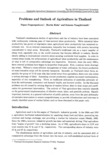Problems and Outlook of Agriculture in Thailand
JIRCAS international symposium series
| ISSN | 13406108 |
|---|---|
| NII recode ID (NCID) | AA1100908X |

Full text
intlsymp-6_45-62.pdf670.44 KB
Thailand's simultaneous decline of agriculture and rise of industry have been associated with continuously widening gaps of inter-sectoral labor productivity. While industrial labor productivity has grown at impressive rates, agricultural labor productivity has remained notoriously low. As an internal consequence, inequality has increased, with poverty becoming concentrated in rural areas. Externally, Thailand's traditional role as a major supplier of cheap food, especially rice, to the world economy has become difficult to sustain, thereby clearly adding to international concerns about securing worldwide food supplies. In order to reverse these trends, the enhancement of agricultural labor productivity and the maintenance of what is left of comparative advantage are imperative. However, since the early 1990 s, three internal problems have begun to jeopardize those goals. First, a serious water shortage has arisen. Without a more efficient management of water utilization, the future production of water-intensive crops will be severely hampered. Secondly, as Thailand's labor force, especially the group of 15-24 year olds, has turned away from agriculture, there now also exists a serious shortage of labor. Sustaining current production requires increased mechanization, especially of rice transplanting. Third, an inefficient utilization of pesticides adversely affects the environment, consumers' and farmers' health, and farmers' profits. As the discussed problems are all caused by varying degrees of market failure, there is clear scope and justification for government intervention. The outlook of Thai agriculture thus crucially depends on the government's implementation of effective water, labor, and pesticide policies. Equally important, however, is a general redirection of public policies, away from the past philosophy of extensive intervention to ensure competitiveness, to provide infrastructure and intervene in clearly identified areas of market failure, such as those discussed in this paper, only.
| Creator | Nipon Poapongsakorn Martin Ruhs Sumana Tangjitwisuth |
|---|---|
| Publisher | Japan International Research Center for Agricultural Sciences |
| Available Online | |
| Issue | 6 |
| spage | 45 |
| epage | 62 |
| Language | eng |
